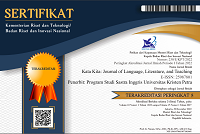MOTIVATIONAL STRATEGIES APPLIED IN THE FIRST GRADE OF PRIMARY SCHOOL
(1) English Department, Faculty of Letters, Petra Christian University, Surabaya, Indonesia
(2) English Department, Faculty of Letters, Petra Christian University, Surabaya, Indonesia
(*) Corresponding Author
Abstract
Keywords
Full Text:
PDFReferences
Al-Mahrooqi, R., Abrar-ul-Hassan, S., & Asante, C. C. (2012).Analyzing the Use of Motivational Strategies by EFL Teachers in Oman.Malaysian Journal of ELT Research, 8(1), 36-76.
Cheng, H-F. &Dörnyei, Z. (2007). The Use of Motivational Strategies in Language Instruction: The Case of EFL Teaching in Taiwan. Innovation in Language Learning and Teaching, 1(1), 153-174.
Dawson, C. (2007). A practical guide to research methods: A user-friendly manual for mastering research techniques and projects (3rd edition). Oxford: How To Books Ltd.
Djigunović, J., M. (2012).Attitudes and Motivation in Early Foreign Language Learning.Center for Educational Policy Studies, 2(3), 55-74.
Dörnyei, Z. (2001). Motivational Strategies in the Language Classroom.Cambridge: Cambridge University Press.
Hecht, M., A. &Ambady, N. (1999). Nonverbal Communication and Psychology: Past and Future. The New Jersey Journal of Communication, 7(2), 1-15.
Merriam, S., B. (2009).Qualitative Research: A Guide to Design and Implementation.San Fransisco: Jossey-Bass.
Thomas, A., M. (1987).Classroom Interaction.Oxford: Oxford University Press.
Zacharias, N., T. (2012).Qualitative research methods for second language education: A coursebook. Cambridge: Cambridge Scholars Publishing.
DOI: https://doi.org/10.9744/katakita.3.4.71-78
Refbacks
- There are currently no refbacks.
Supported by:
Indexed in:
Tools:
Stats (installed since 17 December 2018)
View My Stats













